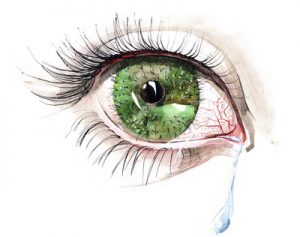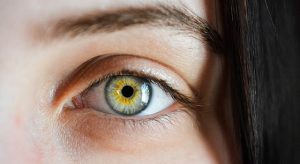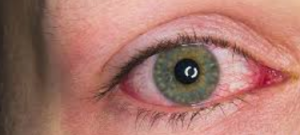Visual disturbances affect over 50% of all people, but what are they?
A visual disturbance is defined as anything that impacts the ability to see clearly and comfortably.
There are many different eye conditions that can lead to a visual disturbance— both temporary and permanent.
Here are the 9 most common conditions that cause visual disturbances.
1. Color blindness
There are two different forms of color blindness, partial and total.
Partial color blindness affects the ability to differentiate between two different colors or shades of the same color.
The most common form of partial color blindness, affecting 1 in 12 males, causes the confusion of dark shades of red and green, and results in both colors appearing as brown.
Why do more males have color-blindness?
Over 8% of males have a color vision problem.
Males have 1 X chromosome and 1 Y chromosome, and females have 2 X chromosomes. The genes that can give you red-green color blindness are passed down on the X chromosome.
Since it’s passed down on the X chromosome, red-green color blindness is more common in men.
Total color blindness is rare. This form inhibits color perception altogether and causes everything to appear in different shades of gray.
Color blindness can be both congenital and acquired.
The following conditions can cause color blindness:
- Genetics
- Aging
- Diabetes
- Certain medications
- Exposure to certain chemicals
- Optic neuritis
- Macular degeneration
- Certain diseases, such as sickle cell anemia and Parkinson’s
2. Double Vision
Double vision, clinically termed diplopia, causes a single object to appear as two images— with the second image appearing horizontally or vertically attached to the first. Double vision can occur from one or both eyes.
Double vision is commonly caused by a miscommunication between the eyes and brain.
Other causes diplopia include:
- Eye injury
- Migraine
- Stroke
- High blood pressure
- Aneurysm
- Diabetes
- Tumor
- Cataracts
- Corneal infection
- Certain nerve conditions
- Autoimmune disorders
3. Halos and glare
Halos and glare appear as circles of light around an object.
Seeing halos can be a sign of many conditions, including:
- Migraine
- Cataracts
- Corneal disease
- Glaucoma
4. Partial blindness
Partial blindness allows for light and shadows to be seen, while total blindness is the complete absence of sight and light.
Some causes of partial blindness include:
- Eye trauma
- Stroke
- Tumor
- Cataracts
- Diabetes
- Glaucoma
- Inflamed optic nerve
- Macular degeneration
SEE RELATED: When is Blurred Vision a Medical Emergency?
If you or a loved one experiences any type of visual disturbance, contact an eye doctor near you for guidance on what to do next.
5. Blurred vision
Blurred vision is one of the most common visual disturbances, often resulting from a change in optical prescription. Any type of refractive error, including nearsightedness, farsightedness and astigmatism, causes images to appear blurry.
Other common causes of blurred vision include:
- Cataracts
- Dry eye syndrome
- Glaucoma
- Eye injury
- Eye infection
- Ocular migraine
- Tumor
- Stroke
- Optic nerve problems
6. Wavy vision
Wavy vision causes straight lines to appear bent or wavy.
Conditions that can cause wavy vision include:
- Macular degeneration
- Macular dystrophies
- Retinal conditions
- Keratoconus
- Astigmatism
- Pink eye
7. Eye Pain
Eye pain of any sort can interfere with vision.
Although many factors can lead to eye pain, the most common include:
- Headache
- Migraine
- Eye infection
- Eye injury
- Contact lens problems
- Stye
- Glaucoma
- Optic nerve inflammation
8. Eye flashes
Photopsia, or eye flashes, are described as tiny sparks or strings of light that appear in your visual field. They can appear in one or both eyes and present in varying colors and shapes.
A sudden appearance of eye flashes is a medical emergency, usually caused by any of the following:
- Retinal detachment
- Posterior vitreous detachment
- Optic neuritis
- Pressure on the retina
- Certain medications
- Migraine
- Eye injury
- Diabetic retinopathy
- Occipital epilepsy
9. Floaters
Floaters appear as tiny particles floating in your visual field and are generally noticed when looking at a light colored surface or background.
A sudden onset or increase in the amount of floaters can be a medical emergency.
Floaters are often caused by:
- Aging
- Eye trauma or infection
- Eye inflammation
- Post-surgery complications
- Retinal tear
- Retinal detachment
- Diabetic retinopathy
- Nearsightedness
What to do when experiencing a visual distortion?
Some cases of visual distortions are considered a medical emergency and require immediate attention.
If you are unsure what to do, speak with your optometrist about the next steps, and whether you should be seen right away.
Your optometrist will examine your eyes to determine what is causing your visual disturbance and discuss the most appropriate treatment.
In some cases, a visual disturbance can be relieved with a change in optical prescription or medication, and in other cases, it may resolve on its own.
Any type of visual disturbance, requires an examination by an eye doctor.
Even if your vision returns to normal, it is still important to speak with your eye doctor and inform them of your temporary visual disturbances.
An eye exam can ensure your eyes remain healthy and vision clear, and can also help identify any early signs of disease.
LEARN MORE: Guide to Eye Conditions
Schedule an appointment with an eye doctor near you for a comprehensive eye exam.
Distorted vision impacts your eyesight and can be caused by a wide range of eye diseases and conditions.
In some cases, serious sight-threatening eye conditions can be detected early on, with the first appearance of visual distortions.









